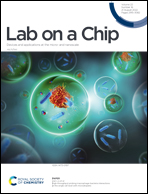Drop-of-sample rheometry of biological fluids by noncontact acoustic tweezing spectroscopy†
Abstract
Knowledge of rheological properties, such as viscosity and elasticity, is necessary for efficient material processing and transportation as well as biological analysis. Existing rheometers operate with large sample volume and induce sample contact with container or device walls, which are inadequate for rheological analysis of sensitive fluids limited in availability. In this work, we introduce acoustic tweezing spectroscopy (ATS), a novel noncontact rheological technique that operates with a single 4–6 μl drop of fluid sample. In ATS, a sample drop is acoustically levitated and then exposed to a modulated acoustic signal to induce its forced oscillation. The time-dependent sample viscosity and elasticity are measured from the resulting drop response. The ATS measurements of polymeric solutions (dextran, xanthan gum, gelatin) agree well with previously reported data. The ATS predicts that the shear viscosity of blood plasma increases from 1.5 cP at 1.5 min of coagulation onset to 3.35 cP at 9 min, while its shear elastic modulus grows from a negligible value to 10.7 Pa between 3.5 min and 6.5 min. Coagulation increases whole blood viscosity from 5.4 cP to 20.7 cP and elasticity from 0.1 Pa to 19.2 Pa at 15 min. In summary, ATS provides the opportunity for sensitive small-volume rheological analysis in biomedical research and medical, pharmaceutical, and chemical industries.



 Please wait while we load your content...
Please wait while we load your content...